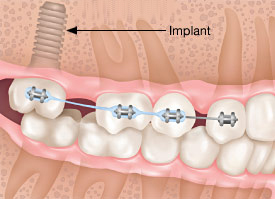Nowadays, implants are widely used in orthodontics as the means of alternative fixed support in orthodontic treatment of maxillofacial abnormalities. Their popularity is explained by:
- high efficiency,
- reduced treatment time,
- minimum risk exposure for patients,
- more easily predicted results of treatments without patient’s involvement,
- minimum costs,
- wider indications and orthodontic treatment alternatives.
A temporary implant is used in orthodontic treatment as fixed support while teeth movement and, unlike natural teeth, it doesn’t change its position under the action of forces.
Temporary implants, placed for the time of orthodontic treatment, do not involve incision, as a rule. They are placed through masticatory mucosa found on attached gingival. They have a thread and are typically made of titanium and its alloys. The surface is rough which contributes to improved osseointegration.
Surgical procedure of orthodontic implant placement consists of several successive stages:
Infiltration anaesthesia over the spot where the implant will be placed, done with a low dose of anesthetic agent.
Osteotomy, done with precision drills with low speed and refrigeration anesthesia.
Sterile implant is removed from cannula and placed using a special tool.
The implant is inserted into the hole and accurately placed in the bone.
After its placement, intraoral X-rays are done for control of implant position.
The application of temporary orthodontic implants has been recognized for high tolerability in patients of the surgical procedure of implant placement, fast adaptation after implant placement, absence of side effects and reduced orthodontic treatment time. It’s worth mentioning that application of this relatively new method make the orthodontist more independent from patient compliance. What is more, the method ensures high stability of implant position, which allows for wider indications and opportunities for orthodontic treatment in adults as well as makes it easier to project final treatment results.

